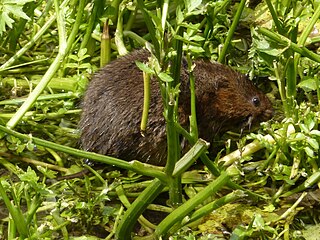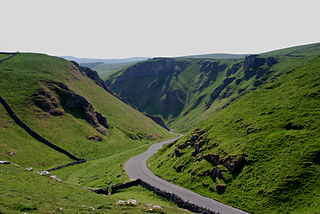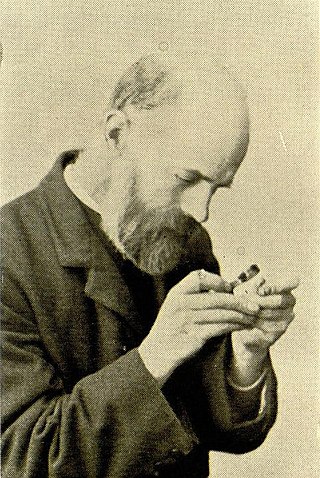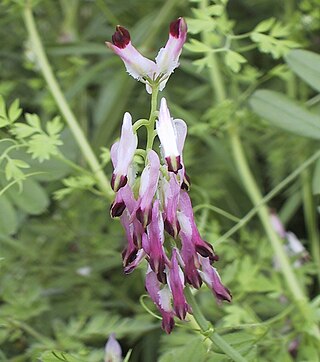
Derbyshire is a ceremonial county in the East Midlands of England. It borders Greater Manchester, West Yorkshire, and South Yorkshire to the north, Nottinghamshire to the east, Leicestershire to the south-east, Staffordshire to the south and west, and Cheshire to the west. Derby is the largest settlement, and Matlock is the county town.

Hieracium , known by the common name hawkweed and classically as hierakion, is a genus of flowering plant in the family Asteraceae, and closely related to dandelion (Taraxacum), chicory (Cichorium), prickly lettuce (Lactuca) and sow thistle (Sonchus), which are part of the tribe Cichorieae. Hawkweeds, with their 10,000+ recorded species and subspecies, do their part to make Asteraceae the second largest family of flowering plants. Some botanists group all these species or subspecies into approximately 800 accepted species, while others prefer to accept several thousand species. Since most hawkweeds reproduce exclusively asexually by means of seeds that are genetically identical to their mother plant, clones or populations that consist of genetically identical plants are formed and some botanists prefer to accept these clones as good species whereas others try to group them into a few hundred more broadly defined species. What is here treated as the single genus Hieracium is now treated by most European experts as two different genera, Hieracium and Pilosella, with species such as Hieracium pilosella, Hieracium floribundum and Hieracium aurantiacum referred to the latter genus. Many members of the genus Pilosella reproduce both by stolons and by seeds, whereas true Hieracium species reproduce only by seeds. In Pilosella, many individual plants are capable of forming both normal sexual and asexual (apomictic) seeds, whereas individual plants of Hieracium only produce one kind of seeds. Another difference is that all species of Pilosella have leaves with smooth (entire) margins whereas most species of Hieracium have distinctly dentate to deeply cut or divided leaves.
A dry roadside dotted with small, ¾ inch red orange flowers, interspersed with very similar yellow ones, and often the white of daisies, is a good sign that you are in Hawkweed country.

The Botanical Society of Britain and Ireland (BSBI) is a scientific society for the study of flora, plant distribution and taxonomy relating to Great Britain, Ireland, the Channel Islands and the Isle of Man. The society was founded as the Botanical Society of London in 1836, and became the Botanical Society of the British Isles, eventually changing to its current name in 2013. It includes both professional and amateur members and is the largest organisation devoted to botany in the British Isles. Its history is recounted in David Allen's book The Botanists.

The United Kingdom Biodiversity Action Plan or (UK BAP) was the UK government's response to the Convention on Biological Diversity, opened for signature at the Rio Earth Summit in 1992. The UK was the first country to produce a national Biodiversity Action Plan. It was published in 1994 and created action plans for priority species and habitats in the UK that were most under threat so as to support their recovery.

Winnats Pass is a hill pass and limestone gorge in the Peak District of Derbyshire, England. The name is a corruption of 'wind gates' due to the swirling winds through the pass. It lies west of the village of Castleton, in the National Trust's High Peak Estate and the High Peak borough of Derbyshire. The road winds through a cleft, surrounded by high limestone ridges. At the foot of the pass is the entrance to Speedwell Cavern, a karst cave accessed through a flooded lead mine, and which is a popular tourist attraction.
Hieracium snowdoniense, the Snowdonia hawkweed, is a species of flowering plant within the family Asteraceae. The species is endemic to Snowdonia, North Wales.

Hieracium umbellatum, the Canadian hawkweed, Canada hawkweed, narrowleaf hawkweed, or northern hawkweed, is a flowering plant in the family Asteraceae.

Pilosella caespitosa is like several other Pilosella species and has a similar appearance to many of the hawkweeds.

Potamogeton praelongus, commonly known as whitestem pondweed in North America and long-stalked pondweed in Britain, is a large, perennial aquatic plant in the family Potamogetonaceae. It is widely distributed in lakes and rivers in the northern hemisphere, but is sensitive to poor water quality.

Hieracium radyrense, the Radyr hawkweed, is a very rare endemic species restricted to Radyr in south Wales, UK. First identified in 1907 it was described as a variety in 1948 and a species in 1955. and belongs to Hieracium section Vulgata. It has rarely been seen and surveys between 1998 and 2004 indicate that only one population of about 25 plants survives.

Rev. William Richardson Linton, Corpus Christi College, M.A., was an English botanist and vicar of the parish of Shirley, Derbyshire. He was regarded as one of the leading batologists of his day.

Hieracium maculatum, the spotted hawkweed, is a flowering plant species in the genus Hieracium found in Europe. It has been introduced in North America and is considered a weed in Canada.

Hieracium gronovii, commonly known as queendevil, hairy hawkweed, beaked hawkweed, and Gronovius' hawkweed, is a North American plant species in the tribe Cichorieae within the family Asteraceae. It is common and widespread across much of the continent from Ontario south as far as Florida, the Dominican Republic, and Panamá. The plant can be found in rocky, dry, open woods and in fields.
Hieracium longiberbe, known by the common name longbeard hawkweed, is a rare North American plant species in the tribe Cichorieae within the family Asteraceae It has been found only in the Columbia River Gorge along the border between the states of Washington and Oregon in the northwestern United States.

Rubus durescens is a rare British species of flowering plant in the rose family. It is native to England, where the entire global distribution of this bramble is found only within the southern half of the county of Derbyshire. It occurs in hedges, shrubs, wood and heathy areas, and was first described and named in 1892 by the Derbyshire botanist William Richardson Linton. Linton placed an illustration of the plant in gold leaf on the cover of the 1903 version of The Flora of Derbyshire, of which he was the sole author.

Rumex rupestris, commonly known as shore dock, is a species of flowering plant belonging to the family Polygonaceae. Its native range is Western Europe and is one of the world's rarest dock species.
Hieracium hethlandiae, known as Cliva Hill hawkweed, is a species of hawkweed native to Shetland. The species was first published in 1946.

Fumaria purpurea, known as purple ramping-fumitory, is an annual flowering herbaceous plant in the poppy family which is endemic to the British Isles.
Estonia is a small, heavily forested country situated on the Baltic Sea. It is a part of the Euro-Siberian region of terrestrial Palearctic realm, and the Temperate Northern Atlantic marine ecoregion.















